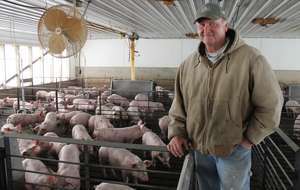
Musings of a Pig Farmer
by Larry Sailer
Willie Nelson, who first organized Farm Aid in 1985 to raise awareness for the farm crisis and to raise funds to keep families on their land, is still actively promoting “family farms” today. In a recent article to The Huffington Post, Willie writes:
“Despite all they’re up against, family farmers persevere. Each and every day they work to sustain a better alternative – an agricultural system that guarantees farmers a fair living, strengthens our communities, protects our natural resources and delivers good food for all. Nothing is more important than the food we eat and the family farmers who grow it.”
I can agree with these statements. In fact, I wholeheartedly agree with that paragraph penned by Mr. Nelson. It’s just that the two of us are practically diabolically opposed to in the type of system we believe “guarantees farmers a fair living, strengthens our communities, protects our natural resources and delivers good food for all.”
It’s my contention that America’s current agricultural system does this and more! We don’t have to look any further than our neighbors to the north to prove my point.
Sioux County, Iowa, is showing the rest of us what can be done with “a mix of feedlots and biotechnology, Christianity and capitalism, hard work and higher education.” The county’s unemployment was 3.6 percent at the end of 2011, according to a recent Register article entitled, “How cows and pigs have fueled economic growth in northwest Iowa.” Sioux County’s population grew 6.7 percent in the 2010 census, which is 63 percent faster than the rest of our great state. Although the population is growing, cows and pigs still outnumber people there 44 to 1.
The key to Sioux County’s success is livestock farming. Innovative, entrepreneurial-minded farmers and businessmen turned their “geographic disadvantage” into a real advantage. Instead of paying astronomical trucking fees to transport grain to the Mississippi River or load grain onto trains headed to the Pac Northwest, they started feeding local grain to livestock. Sioux County farmers add value to their crops by using it as livestock feed, and as a result, their Main Streets flourish.
Where there’s livestock, there’s economic activity. “Cattle yards and hog confinements require loans, feed and ethanol byproducts for the animals to eat, veterinarians and nutritionists to keep them healthy, truck drivers to transport them to market, as well as contactors to build and wire buildings, repair fences and pour feedlots. Livestock farming generates paychecks to feed mill workers, auctioneers, stock trailer builders and equipment mechanics. You get a ‘flywheel effect’ when dollars compound and gain speed with each transaction.” More examples of economic success and lesson learned can be gleaned from this six-page Register article, and I invite you read it in its entirety.
You’ll see that modern agricultural practices are allowing today’s farmers to make an honest living while strengthen our communities and protecting the environment. And in the end, I’m sure you’ll see that yesterday’s “Global Day of Action” (aka #occupyourfoodsupply) is really based on misconceptions.
Time and effort would be better spent getting to know the American farmers who produce the world’s safest and most abundant food supplies. But don’t just take my word for it. Take a few minutes to read what other farmers like Wag’nTales and The Farmers Life have to say about who controls their family-owned farming operations.
Indeed, “nothing is more important than the food we eat and the family farmers who grow it.” I’m proud to be a fourth generation Iowa farmer.
